“Passion and quality are at the heart of this venture. It’s that simple.”
I sneezed, a clear sign that spring was about to settle onto Andalucía for a brief period of time before melting into summer. The breeze picked up, and I wrinkled my nose, lest any more oliva pollen enter my system. For as andaluza as I sometimes feel and act, my allergies gave me up as an utter fraud, calling attention to me in a group of nearly 50.
Isaac Martín, event coordinator for Basilippo, an award-winning olive oil producer internationally recognized for its quality, kicked off a tasting event that was punctuated by my sniffles. Set at an old hacienda buried within acres of olive trees, an internet search for foodie experiences brought me to one of western Andalucía’s foremost producers of liquid gold, extra virgin olive oil.
Teetering on winter and spring, I was willing to risk puffy eyes to learn how to properly taste olive oil and look out for its quality and properties. As a staple of the Mediterranean diet, its health properties have long been touted, but not all aceite de olivo virgen extra is created equal: supermarket buyers often have to pick between an entire shopping aisle’s worth of brands and varying quality.
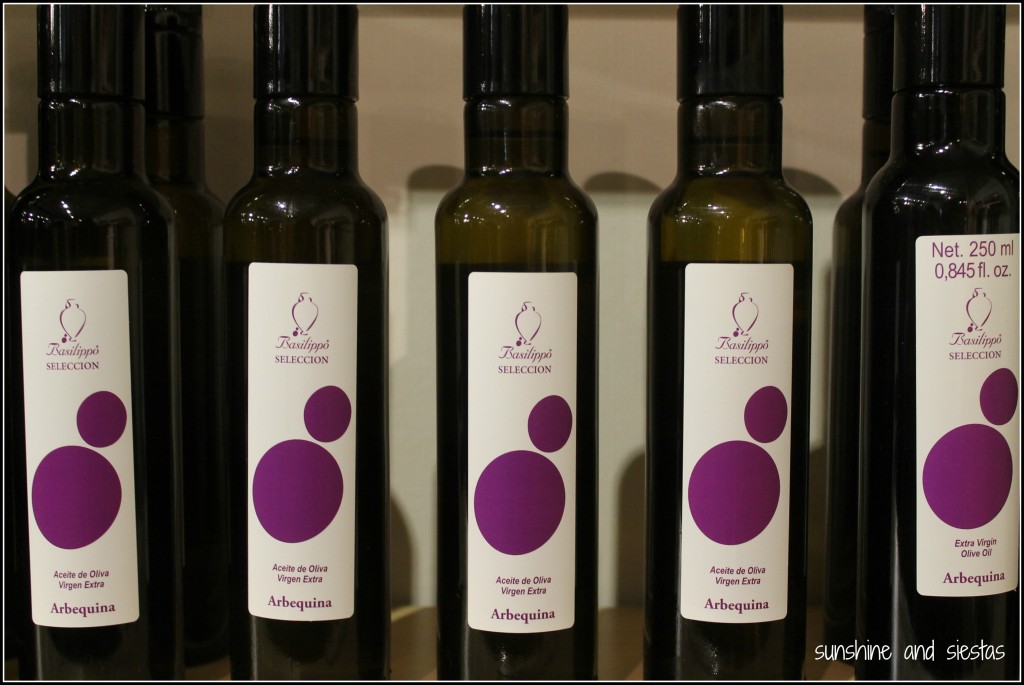
And the good stuff doesn’t come cheap.
The Basilippo brand, made with the manzanilla and arbequina varieties of olives, has been my go-to brand when bringing home a nice bottle for foodie friends, but I shamefully catalogued what I used to cook with or a dress a salad with at home: whatever came cheapest and in a plastic bottle. I had a lot to learn, and creative packaging could not longer be a barometer for quality.
And for a small-batch, family-run brand, passion for the ripest fruit and top-tier production practices, only the best would do.
Inside Hacienda Merrha’s lofty tasting room, several round tables sat armed with jewel blue tasting cups, a brasero disguised underneath by heavy cloaks. Diego Vergara, responsible for the company’s marketing, held up two sherry glasses full of orange juice as we sat.
His explanation of how to distinguish extra virgin olive oil was simple: one was an orange juice squeezed from ripe oranges. The second was a bastardization of orange pulp, colorants, chemicals and mass production. In other words, it was a soft drink meant to mimic the flavor of orange juice. If the product was bruised or off, the taste and aromas would be off. Perfection is this business, amidst mass production and knocks offs, truly came down to passion for the cleanest, most natural product.
The scents naturally found in olive oil – grass, banana and traces of fruit – laced the air as the heater next to our legs in turn heated the smooth, rounded tasting capsules for optimum olfactory pleasure.
Oil exists in dozens of varieties, and olives have been picked, pressed and packaged into olive oil for nearly eight millennia. Extra virgin – considered the healthiest and ripest state of the olive – occurs when no heat treatments have been applied to the product and is made from 100% olives of the same type. All other oils wane in quality, thus driving down the price. Packaging can also make a difference, as olive oil loses its properties with exposure to light or heat.
Again, I fully admit to being ashamed of the marca blanca I have stocked at the back of my pantry.
The three blue cups sat before us. Two contained about a tablespoon of product and were covered with a plastic condiment lid. The third, sitting at 7 o’clock, was filled and quickly covered. Blue cups are typically used in blind tasting as, unlike wine, color is not a factor in determining an oil’s quality. Smell and taste take all the credit here.
Olive oil’s properties are strongest when it’s as close to harvest as possible. The generous pours came from a bottle only a few weeks old, and Diego generated a bit of heat to release its intoxicating smell by cupping the glass in his hand and rotating it back and forth as if opening a bottle of pickles for about 15 seconds. Next came a quick whiff and recapping the jar.
We’d all come for the tasting portion of course, and sloshing it around your mouth like Adolfo of Plus Vino showed me to do wouldn’t cut it:
Olive oil has different tastes on your tongue and taste buds. Sucking in air as it travels towards the back of the throat makes it taste more viscous and potent. And I wasn’t the only one who got a burn in the back of the throat – slurps were followed by gags, coughs and grunts, the sign of a quality harvest.
Moving on, we paired a vanilla-infused organic oil with both regañá crackers and a crisp, hard cheese, as well as a pineapple ice cream drizzled in olive oil. Though most of Basilippo’s bottles come with recommendations for consumption, the kitchen serves more innovative dishes.
The man immediately on my left seemed to be some sort of aficionado and asked the white elephant question: How did Basilippo feel about the “adulteration” of Spanish olive oil?
Brought up as extended family of the Rubinellis and the Dell’Alpe dynasty – a Chicago-based import company known for its quality Italian products – olive oil has always been a staple in my family’s kitchen. And until moving to Spain, I was convinced that Italy produced the highest quality product. But European olive oil is on par with organized crime – even though Spain produces roughly 40% of the world’s olive oil, most is shipped in bulk to Italy before being bottled, giving the impression that most olive oil is coming straight from the Boot.
This has been going on since the Roman occupation of Spain, when olive oil was used in commerce and called liquid gold (and in all fairness, my Italian relatives have a soft spot for Spanish cuisine). I’ve long felt that Spain is only beginning to embrace competing on an international market with its food products, and I’d likely consumed them as they paraded as Italian.
But Basilippo’s product was meant to stay with the connoisseurs, a thead that runs thorughout its four generations of olivareros. International consumption is definitely on the table – they’ve won numerous awards worldwide and run a quality assurance program attended by visitors abroad – and they’ve got a strong local following. I thought back to Isaac’s powerful speech in which his love for his business reach my consciousness despite the sneezing and nose blowing. Passion isn’t so much an ingredient, but a habit at Merrha.
Diego explained that close to 10 pounds of olives are necessary to produce a single liter of olive oil of any quality, hence the small batches coming out of Basilippo (the production comes from just 20 hectacres of olivos). By the time our group of nearly 50 hit the gift shop, we’d depleted a large portion of stock. I introduced myself to Isaac, chuffed that so many phenomenal gastronomic treats now formed an important base in my diet.
Unsatisfied with a few morsels of bread for mopping up oil in the gift shop, I sneezed my way back to the car and we struck out towards El Viso del Alcor. Craddled between Mairena and El Viso, this privileged land was believed to have been inhabited as Tartessos. It’s also home to one of the zone’s most innovative tapas bars, MasQueTapas.
All of the dishes on the two-paged menu are made with products from down the road at Basilippo and the place was packed on a rainy Saturday. As the waiter brought out drinks, he laid down a small dish of fried olives.
“But heating the olives changes their properties,” Kelly said, popping one into her mouth. “So these are probably the rejects.”
Low quality or not, they were exquisite, proof that a small sliver of land in my backyard, with its rolling groves of olive trees (and toxins for my system) is producing what could be the world’s most perfect crop.
I’m on a mission to do something new every week of 2016 – from visiting a new village to trying a new bar or restaurant. Have suggestions for in or around Andalucía? Please share them, and take a tour of Basilippo‘s immaculate grounds, just 30 minutes from Seville (they’ll even pick you up if you use public transportation!). You can buy their products in small gourmet shops like Oleo-lé in central Seville.
Have you ever attended a strange food tasting?


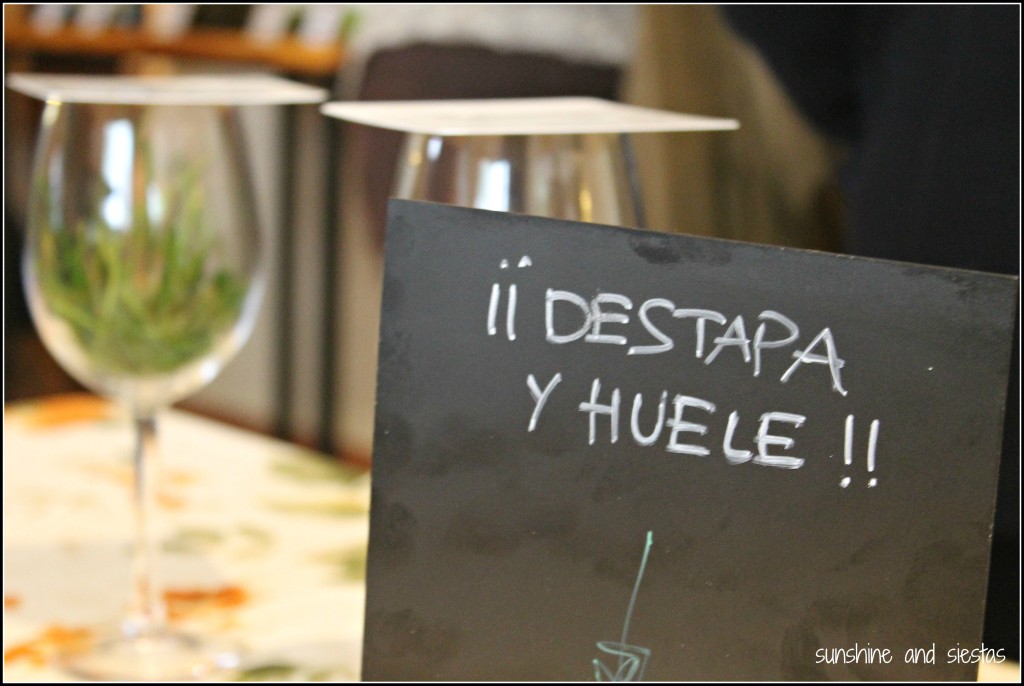
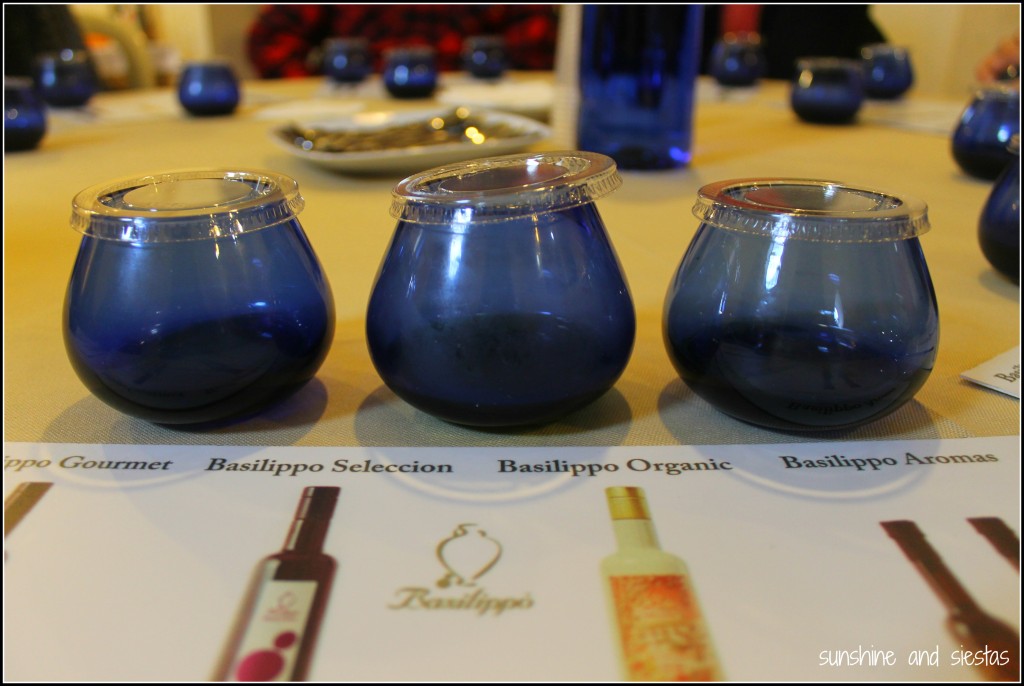
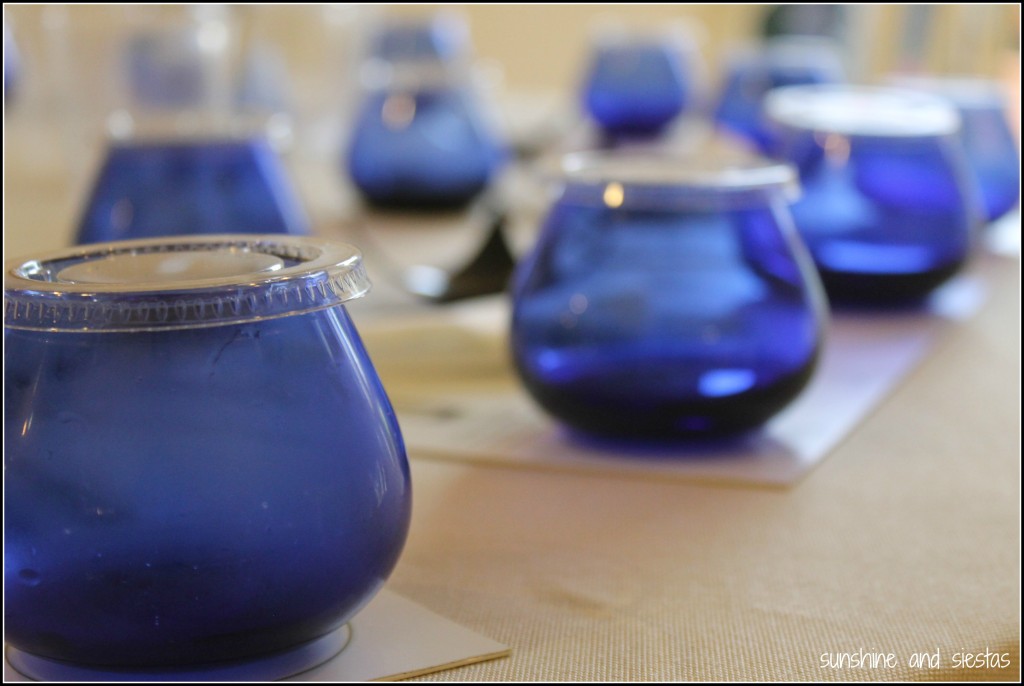
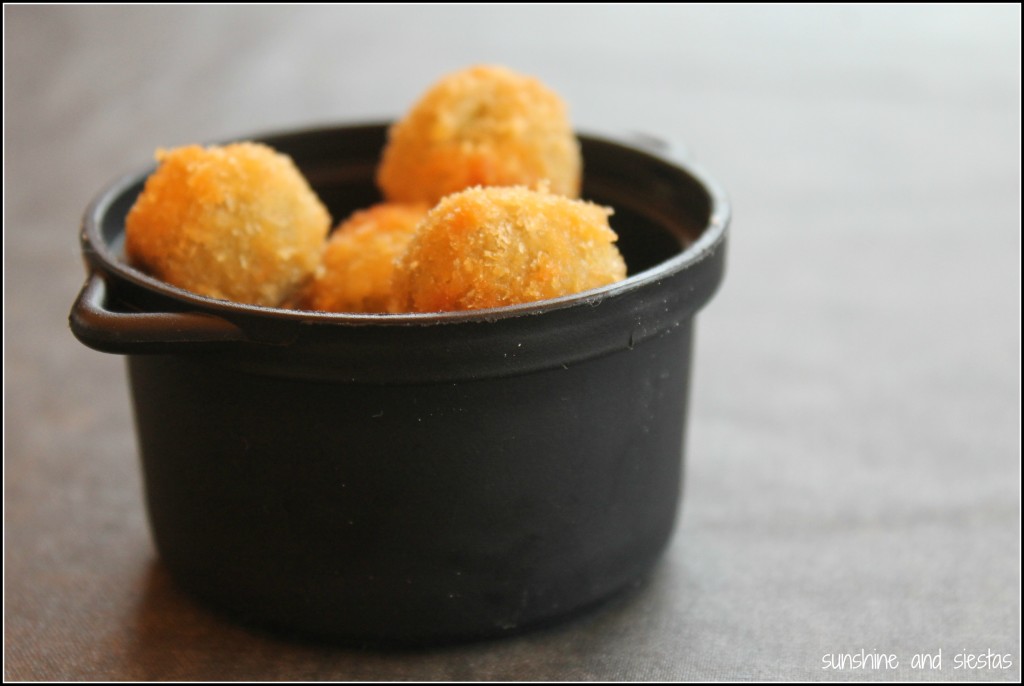
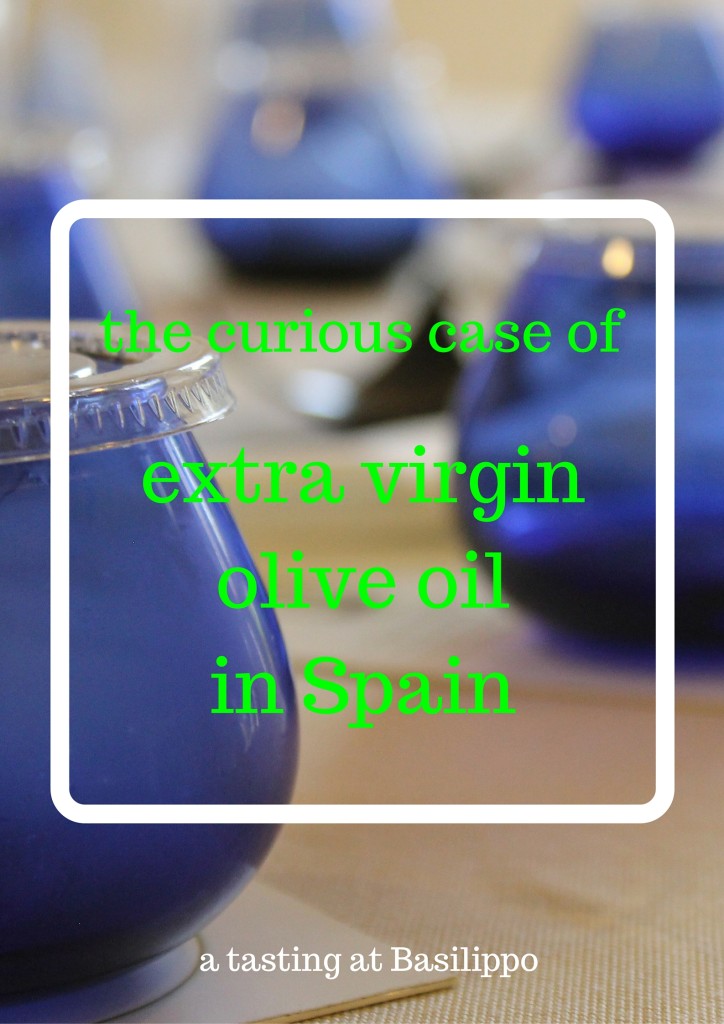





I was always under the impression that the majority of quality olive oil came from Italy too. And so many olives sacrificed to make one bottle! I had a chuckle at the end of that video Cat :), haha.
Andy recently posted..A Spanish Festival in Sanlúcar de Barrameda
I had to leave in the gagging!
A stellar write-up of your olive oil tasting experience, Cat! I really enjoyed this narrative/story-based angle you used to present your experience at the almazara.
Andalusian aceite is simply the best…speaking of which, how did you and Kike enjoy the tin of ubetense oil I brought back with me from Úbeda?
P.S. get thee to Jaén before allergy season begins! 😉
Trevor Huxham recently posted..Mornings in Spain
I always thought Italian olive oil was the best until I went to Spain and tried it there. So incredible!! This tasting experience sounds wonderful!!
Valen-Eating The Globe recently posted..The Zipolite Restaurants Guide: The Restaurants You Have To Visit (And A Few You Shouldn’t)
I love this!
I have allergies, too, so I’d be sneezing.
it is interesting that foreigners may see that Italian olive oil is the best, or at least it seems to get all the fame….well Spain’s olive oil always has been and it is the best!
not long ago i watched the TV programme How It Is Made/How Do They Do It on Discovery Max…they showed how olive oil is produced and, one thing got my attention and made me fume: it was in Italy! what’s next on such a TV channel? bullfighting in southern France? you know that bullfighting is also popular in that place!
I love Spanish Olive Oil! On my first trip to Spain, I came home with a backpack full of the good stuff, yum!
Mary @ Green Global Travel recently posted..Time in a Bottle: Exploring Ngorongoro Conservation Area
Just discovered your blog. Love it!
Thanks Jodi – looking forward to interacting!
I love the writing in this post. “Unsatisfied with a few morsels of bread for mopping up oil in the gift shop, I sneezed my way back to the car and we struck out towards El Viso del Alcor.” Love it! And now I’m craving olive oil.
“Unsatisfied with a few morsels of bread for mopping up oil in the gift shop, I sneezed my way back to the car and we struck out towards El Viso del Alcor.” Love it! And now I’m craving olive oil.
Lillie recently posted..She’s Here! Our New Baby is Here! Woo Hoo!
I’d say it’s great for baby, but you’ve already gotten you second bundle of joy! Congrats again!
Olive oil freak here! Very nice article. We live in Spain for 12 years and the oil is the best (and occasioanly cheeky vino!). x
Eating lots of tapas is surely one of the best reasons to visit Spain. Also I often drink a teaspoon of extra virgin olive oil…delicious!
Hi Cat!
I was so delighted to find your website and blog, and this post truly made my day. We just got back from Sevilla (and now I’m planning to go back for the 2023-2024 school year with my little family of 3 humans and a small but mighty Chiweenie). While we were in Sevilla, we had the chance to visit Isaac at Basilippo and sample the unbelievable olive oils they produce there. Orange infused olive oil on chocolate gelato? Fuhgedaboudit. We live in Northern California and the whole experience felt like the Napa of Spain. Absolutely gorgeous. Look forward to reading more from you. Best. K
Thank you, Kristen! What a delight to have read your comment, and I hope to meet you once you’re in Seain with your family.
Olive oil from Spain really? Wow I never had a clue definitely gonna have to see the differences first hand.
Patrick recently posted..Add Olive Oil In Protein Shake? Should I Put Olive Oil In Protein and Is It Worth The Calories?